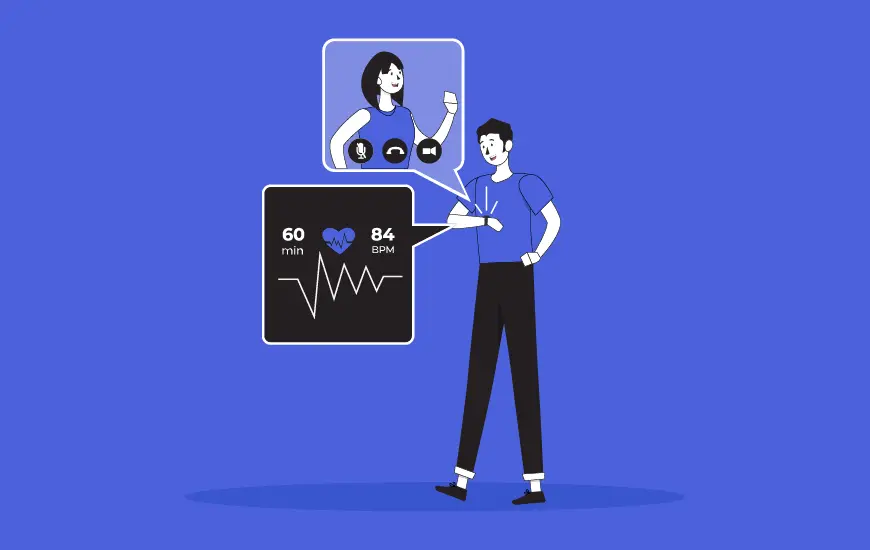- Current Market Overview of Wearable App Development
- How Wearable App Development Differs From Standard Mobile App Development?
- Types of On-Demand Wearable Apps and Devices
- 1. Smartwatches
- 2. Smart Eyewear
- 3. Fitness bands
- 4.Head mounted displays
- Most Promising Industries to Develop Wearable Apps and Devices
- Gaming
- Fitness and sports
- Education
- Retail and Fintech
- Healthcare
- Planning Your Wearable App : How To Get Started
- 1. Brainstorming
- 2. Collecting data
- 3. Project planning checklist
- How To Develop a Wearable App : Factors To Consider
- 1. App complexity
- 2. User Base
- 3. Security
- 4. Integration
- 5. Prototyping
- How To Design Your Wearable App?
- 1. Glanceability
- 2. Context
- 3. User Interface
- How Much Does It Cost To Develop a Wearable App?
- How Can Appinventiv Help You With Wearable App Development?
If you have a revolutionary product idea, you might have already considered building a cross-platform application medium of your product. However, there are high chances that wearables app development might not have even crossed your mind.
No matter how great your product is, if it doesn’t penetrate deep into your everyday customer’s life via smartwatches, smart glasses (google glass), fitness trackers, etc, there are high chances that your customers might go to your competitors rather than waiting. This highly calls for the need of wearable technology app development.
Keeping the ever evolving demands of your customers in mind, this article answers all your questions on the wearable app development process, how much does it cost to develop a wearable app and how to design your first wearable app.
So let’s begin by taking a quick glance over the current market standing of wearable technology and apps.
Current Market Overview of Wearable App Development
- The number of connected wearable devices worldwide have already crossed the figure of 1 billion.

- As per the recent surveys, the wearable technology market size is anticipated to be valued at 265.4 billion by 2026, growing at a CAGR of 18% from 2021-2026.
- By the end of 2022, the total shipments of wearable devices are predicted to reach over 344 million and over 650 million by the year 2027.
- It is also estimated that in terms of connectivity, 4G smartwatches will be the significant devices shipped with a penetration rate of 5% during 2022, while 5G will appear in 2023, with a low penetration rate of about 0.3%.
As per these figures, there is a huge opportunity for the wearable app development market to grow at the highest rate for the enterprise and industrial application.
Therefore, whether you are entering the digital space for the first time or are looking to expand your already existing digital presence, app development through wearable devices can develop successful experiences for your customers.
Now, let’s talk about how wearable app development is different from regular mobile app development.
How Wearable App Development Differs From Standard Mobile App Development?
A wearable app specifically functions for wearable devices such as fitness trackers, smartwatches, smart glasses etc, to track real time information in sync with bluetooth or wifi.
Mobile apps for wearable devices are designed differently that regular apps, with a customized screen size and hardware set.
What else? Here’s how mobile apps differ from wearable apps:
| Wearable Apps | Standard Mobile Apps |
|---|---|
| The functionality of wearable apps is limited due to small and less powerful hardware | Diverse and varied range of features and functionalities as per the business needs |
| A wearable app is designed to communicate with apps present in the mobile device and typically needs both to carry the intended task | A mobile app can perform on any OS or device |
| Few inputs and user interaction is required to perform | High user interaction is required to perform various tasks including app shift, calling, streaming and more |
| Wearable apps are not cross-platform since they use device-specific APIs | Mobile apps can be developed on any operating system and platform including Android, iOS, cross platform and hybrid |
However the user interaction is limited, wearable app development is a promising market for businesses looking to connect with their customers on a personal level. Now that a significant user base is dependent on various on-demand wearable app solutions, let’s see what wearable device and app development services are available in the market.
Types of On-Demand Wearable Apps and Devices
Functional on IoT technology, wearable app development is highly engaging and user centric for businesses pursuing to personalize customer experience. The popular wearable app development trends are emerging every year to shape technological change in different ways with even more effectiveness and sophistication as they evolve.
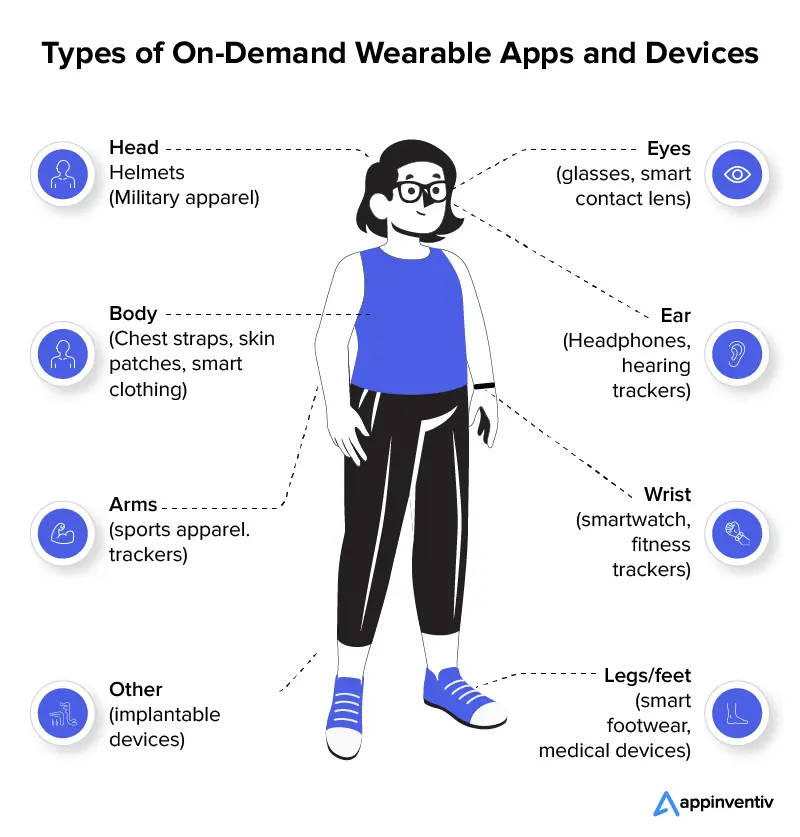
Speaking of trends, here is a comprehensive list of the most popular wearable apps and devices that are never running of style and usage:
1. Smartwatches
As per Statista, smartwatch is the most popular wearable device expected to grow over 253 million by 2025. This wearable app solution allows users to leverage several features inducing pedometers, physical activity tracker, notifications etc.
Smartwatches include sensor related functions that enhance the user experience and make its associated app innovative and feature rich. For instance, Apple Watch, a prominent example of iOS wearable app development.
Key features of smartwatch:
- Heart rate monitor
- Calorie and activity tracker
- SpO2 monitoring
- ECH and ECG app function
2. Smart Eyewear
Smart glasses or eyewear are the next big technological advancement of wearable technology devices that integrate data associated with the object the user visualizes.
Smart glasses collect information from internal and external sensors along with supporting wireless technologies such as Bluetooth, GPS and WiFi.
One renowned example for this could be Appinventiv crafting a wearable voice command app “Vyrb” that allows users leverage social media platforms such as Twitter and Facebook using Bluetooth glasses.
Key features of an smart eyewear:
- Information assessing
- Visual tracking
- Data storage and communication
3. Fitness bands
Fitness bands also known as Fitbits are an ideal choice for fitness enthusiasts to track everyday activities and movements. The wearable app device collects all information and transforms into sleep quality, steps, daily routines and more.
A wearable app development platform for Fitbits helps users with setting goals, monitoring health, connecting with friends and modifying the device interface.
Key features of fitbit:
- Health metric
- Breathing rate
- Oxygen saturation monitoring and more
4.Head mounted displays
AR/VR glasses are the most explicit examples of head mounted displays based on wearable app development solutions. They can be used to monitor and provide information to users on the virtual ecosystem.
You might also want to look at the AR/VR and wearables trend predictions for the coming years
With that being said, There are also other types of wearables apps and devices that are less popular, such as implantable and smart clothing.
Healthcare wearable app development has a crucial significance in the healthcare industry. For instance, glucose monitors allow patients to track their glucose levels. Various diagnostic trackers are used to identify muscle activity, body temperature, chronic diseases, and much more.
The applications and use cases of custom wearable device app development is not just restricted to healthcare. Let’s see what other industry verticals benefit from the app development for wearable devices.
Most Promising Industries to Develop Wearable Apps and Devices
Wearable apps and devices have already been incorporated into different types of industrial application scenarios shaping the enterprise app development.
Take a glimpse to the sectors happily utilizing the benefits of wearable devices and app development.

The following are the most popular next in wearable technology applications in various industries:
Gaming
With AI-enhancing wearables, gaming devices have garnered more user engagement.
With the release of various VR devices, more and more people have started showing interest in AI-backed gaming. Therefore, wearable devices and gaming are often in a symbiotic linear rate with a common goal of giving the target audience an interrupted AI-driven experience.
Fitness and sports
Body-mounted AI wearable devices can successfully provide complete fitness information to their users, simply with voice assistants and real-time insights..
Besides, the AI-enabled bluetooth devices that occur in the form of fitness trackers are now featured with biosensors. These biosensors detect elevation, heart rate, proximity, motion, and touch.
Popular examples of app development for wearable devices are GoogleFit, Strava, Nike+ etc.
Education
Thanks to AR/VR and wearables, there is a huge advancement in the field of education when it comes to learning virtually. Wearables like Google Glass help with detailed anatomy of objects along with the data and other crucial information. Wearables have also been extremely useful in studying small molecules and exploring virtual dimensions for research purposes.
Retail and Fintech
Wearable supporting mobile apps are now synced with AI-driven wearable apparel like hand gloves, jackets, etc., specifically made to ensure the user’s or wearer’s safety.
Wearable app development is also highly utilized by the fintech and insurance sector since the smartwatches today support NFC sensors to enable contactless payments.
For instance, Apple Pay and Google Pay are two most popular payment apps based on wearable application development.
Healthcare
With wearable technology app development in healthcare, it is now possible for patients to take precautionary healthcare measures at home by keeping track of their health details.
Moreover, Healthacre industry uses wearable app development and devices in the form of glucose monitors, smart bands, diagnostic chips etc.
Apart from these applications, Wearable app development solutions are efficiently leveraged by digital businesses supporting social media, map and navigation, and more.
You might also want to check the detailed applications of Wearable AI: implementation in the digital world.
As per these use cases, it’s worth saying that VR-based wearable apps are ready to modernize the world.
Therefore, let’s cut to the chase and uncover how to get started with wearable app development by planning, designing and developing your business wearable app.
Planning Your Wearable App : How To Get Started
If you’re a beginner, you’ll find wearable electronics to be the most frustrating yet fascinating technology at the same time. Apart from coding and circuit design, there are several other things that you need to consider before starting to build your wearable device apps.
The task of brainstorming, getting a clear idea about the type of app that you want and types of components that you want to include, and so forth, are some of the planning ideas that need to be clear.
Let’s discuss and know how to plan properly for smooth execution.
1. Brainstorming
Before starting any project, you need an idea, a plan of how to do it, what to include, and so on. Thus, start by making a rough outline of your app and include what the app should do, how it should look, and what all to include.
Since we are just mapping out the possibilities and functionalities that should be there, thus this is the phase where you are free to use your imagination and preferred method of placing the ideas such as determining common mistakes while launching a wearable app , making a list of features that are required to create a wearable app, and making a list of the users that use the feature most.
2. Collecting data
Wearable apps devices make use of user data to improve their functioning and provide accurate information to the user. Providing value to users in terms of wearable products requires context for any data that the app sensors collect. Without understanding the context of collected data, the result may be twisted or inaccurate.
Thus, to have precise data, the focus should be made on developing app sensors for android wear apps, smartwatches for iOS, and other devices.
3. Project planning checklist
Make a proper checklist of questions while declaring the specifics of your project. Moreover, consider adding questions such as how durable the project needs to be, whether you want to make the circuit transparent or not, who will be the user, functionalities to include for the user, and so on.
Having questions gives you an idea about the project and its developing process along with the kind of device that is to be made.
For example, whether the app will be for android or iOS, such as smartwatches for iOS, android wear smartwatch, wearable web apps, and so on.
You might also want to read an all inclusive checklist on mobile app development
When you are done with your checklist, the only question left is “how to design and develop your wearable app”?
How To Develop a Wearable App : Factors To Consider
After you’ve done some basic prototyping with your ideas and features, you need to refine your sketch of the layout to make it even more understandable and easy to follow. In this process, you’ll also have several opportunities to find any problems with the design.
This allows you to make necessary changes before starting the app development process. A final sketch also acts as a guideline to make sure that all the features are finalized during the process to build a wearable device application.
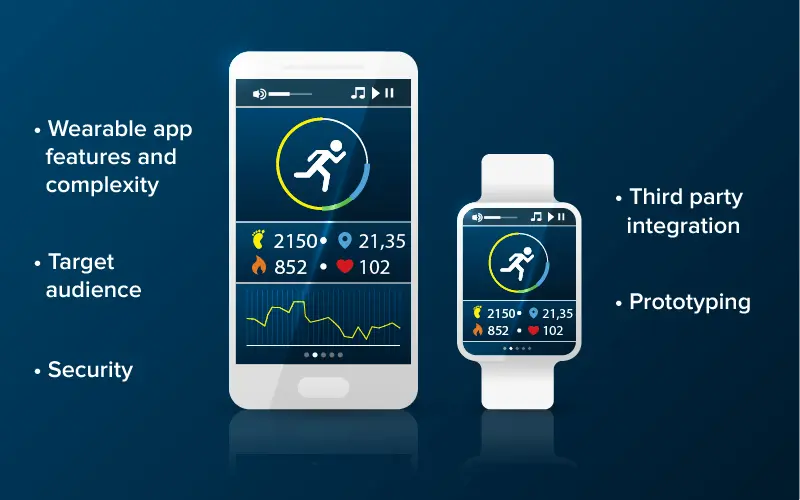
1. App complexity
For example, the computation power and the machine that a smartphone uses have been designed to meet the high real-time specialized requirements. But a wearable, independent of its form, is devised to deal with direct connections and not to go to a ton of computational requirements.
Noticing the intrinsic contrasts, when you make a mobile application for your wearable device, you should choose which sort of apps to show in the wearable and which ones to avoid.
2. User Base
Since the user base is different for smartphones and wearables, thus the app making will also be different accordingly. It is important to understand and know for whom the app is being developed, what kind of app is created according to the demographic, and what necessary changes need to be made.
3. Security
Data is collected whether you are using smartphones or wearable devices. But the data collected from wearables is extremely critical as the information is sensitive according to the person’s location, health information, likes, dislikes, habits, etc. Thus, for wearable app developers, it is extremely important to take care of the personal information of the user and ensure that the security remains intact when using that information.
4. Integration
The evolution of wearable apps has affected consumers, brands, and app developers. Businesses are empowering their administration with intuitive wearable apps development that integrate seamlessly with a wide range of connected devices and sensors.
Integrating wearable apps with multiple systems provides the ease of operating various applications with just a touch of our fingers.
For integration to succeed, your wearable app developer must start with finalizing which all data will be required for the functioning of a wearable application and then use SoC (system-on-a-chip) to native interface with a number of sensors and actuators.
Using API, one can share data seamlessly from different wearable devices and apps. Here’s an image depicting functional integration of wearable devices in MCU.
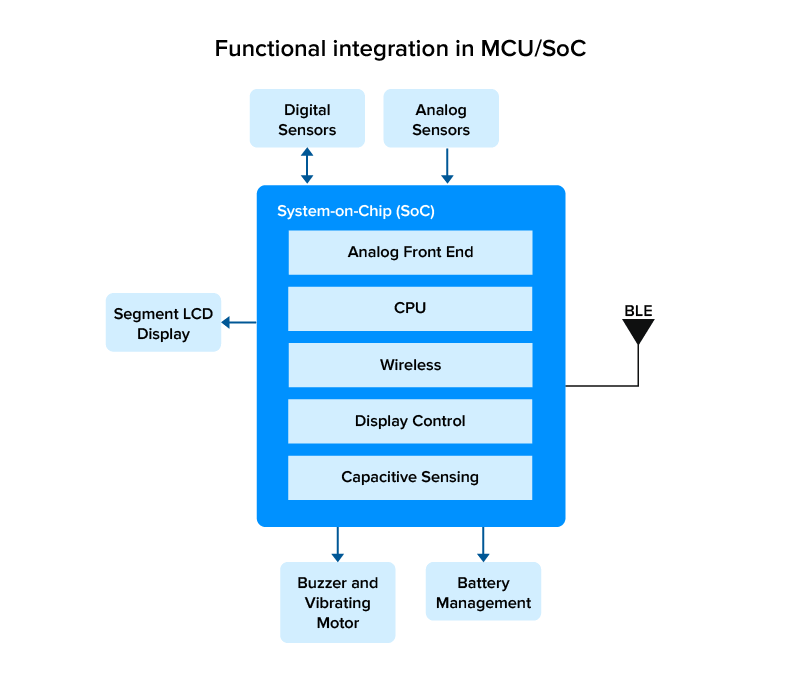
5. Prototyping
The prototype design is important to understand and know your ideas and the purpose behind a design or feature before investing time into the development.
The way the app is interacting with the users and presenting data means a lot. It should be easy and simple to understand. Too much data leads to confusion and a bad user experience. Thus, prototyping is the best option before moving forward with the development and launch.
However, these devices have a unique set of challenges when it comes to their design. There are several limitations such as less information density, smaller screen space, and limited battery life. That’s why they require a different design approach.
How To Design Your Wearable App?
There are numerous choices available in the market (including glasses, watches, rings, and wristbands) and even more are arriving. Your app design should be made to fit with all the multitude of wearable devices, seamlessly.
Here is a detailed insight of the design approach for wearable app development.
1. Glanceability
Wearable designs are destined to be glanceable. For those who don’t know, the term refers to information being shown for limited interactions. A great example can be fitness trackers that rely on lights to explain what’s happening.
2. Context
Talking about the context, it’s the backbone of your design and needs to be used to provide specific information in the least amount of time. When you design a wearable app, you’re automatically designing for the context too because these devices are filled with sensors.
3. User Interface
When designing a wearable it is important to integrate a wearable device with the existing user’s devices. Thus, wearables app development should be made keeping in mind other devices and user interface as well. For example, a blood pressure monitor and heart health app for a smartwatch might be used to gather information/data, but the review and analysis of the data collected can be made through a smartphone.
While this was a brief introduction to the wearable app development process, for better understanding, check out the top 8 tips for wearable app development
Now, let’s end our discussion with the cost involved in making your wearable app.
How Much Does It Cost To Develop a Wearable App?
Answering how much does it cost to make a wearable app is an activity that would need to take several things into consideration. Usually, the cost of developing a wearable app or device ranges from $50,000 to 250,000 and above based on your project requirements.
Since we are not talking about any specific app type but are estimating the cost of developing a wearable app as a whole, there are various factors involved in the budget list. Factors such as wearable app features and wearable app tech stack, outsourced wearable device app development company, the complexity level of your wearable app etc, decides the final cost of wearable app development.
With increasing complexities and functionalities, the cost automatically increases with a certain number of challenges and issues. This is probably, experts advise hiring a reliable wearable app development agency to help you with a smoother development process overcoming all technical challenges.
How Can Appinventiv Help You With Wearable App Development?
Industries are advancing into trending tech wearable app development. Appinventiv is a trusted wearable app development company that can help you build solutions to make your business platform-independent.
Whether it is fitness, medical, lifestyle, gaming, or utilities, our dedicated team of wearable app developers can bring your vision to life through impeccable wearable experiences that feel natural to your users.
Our suite of wearable app development services includes:
- Wearable device app development
- Multi platform integration
- Wearable solution design
- Seamless wearable deployment and more.
So what are you waiting for? Get in touch with our experts to get started.


Excellence Together

The Definitive Guide to Flutter App Development
Flutter has become increasingly popular, establishing itself as the go-to framework for developing cross-platform mobile apps. It can be used to create intuitive and feature-rich apps for different operating systems while achieving native performance and visual consistency on different platforms.
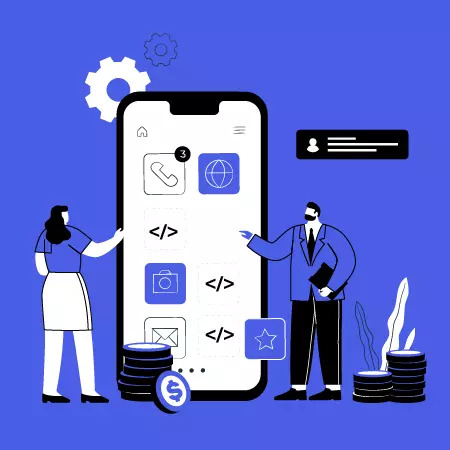
How much does it cost to create an app in 2024? A detailed guide
Ever heard of the phrase, “there’s an app for everything?” well it’s true. According to BusinessofApps, there are 3.3 million of Android apps available on Google Play Store and for the Apple App Store, the number stands closely at 2.2 million. Not only this, a report from Grand View Research estimates that the mobile app…







